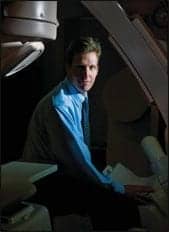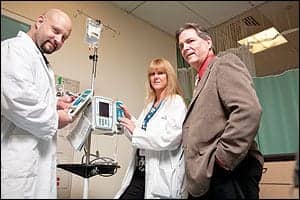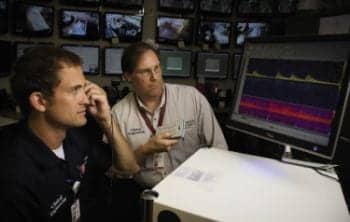On the Cutting Edge of Care
A world renowned medical institution, the Cleveland Clinic is regularly cited as one of the top hospitals in the nation. (Most recently, U.S. News & World Report ranked it as the No.2 hospital in the U.S., trailing only the Mayo Clinic.) Supporting the Cleveland Clinic—and the vast number of devices it houses—is the hospital’s clinical engineering team. Below, Marc Petre PhD, Cleveland Clinic’s executive director for clinical engineering, shares the department’s unique approach to staffing and why maintaining a strong relationship with the institution’s IT department has been a boon to operations.
24×7 Magazine: Can you please tell us a little bit about your team and the workload you handle?
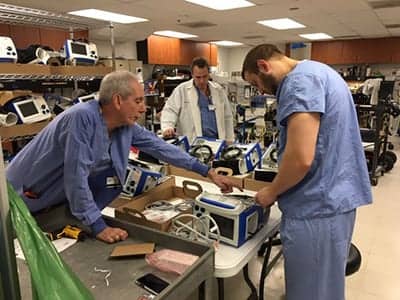
Steve Scaia, Steve Maxon, and Ed Scheiman prepare defibrillators for a system-wide equipment rollout.
Marc Petre: The clinical engineering department at Cleveland Clinic has more than 150 caregivers working across Northeast Ohio and Florida to support about 135,000 medical devices. Our technicians are hospital-based, but also support many ambulatory surgery centers, medical office buildings, and physicians’ offices.
We provide full-service, on-patient monitoring; ventilation; anesthesia and operating room support; and significant coverage of imaging including ultrasound, catheterization labs, and some CT systems. At our main campus in Cleveland, we also provide asset management/logistics services to insure equipment such as infusion pumps and sequential compression devices are clean, functional, and available for care.
24×7: How has Cleveland Clinic’s clinical engineering department evolved recently and how do you expect it to evolve even more in the future?
Petre: The Cleveland Clinic Health System is expanding in the Ohio and Florida markets, which means we have had to learn how to grow and integrate clinical engineering programs. I have been repeatedly impressed by the staff we add as we grow—there are always opportunities to learn from each other. Cost pressures in healthcare have been consistent for the past 10 years, but we emphasize value—a balance of quality and cost—when working with our clinical partners. Currently, we are focusing on bringing increased value to our partners in imaging and lab departments.
Approximately 10 years ago, we added our main campus asset management logistics team to solve distribution and care of infusion pumps challenges. Since then, the 24/7/ 365 service has grown to include other patient care equipment and the highly critical crash carts. This team has become indispensable for daily patient care, and we believe our large and growing campuses may benefit from a similar service in the near future.
24×7: The aging out of the biomed field is a well-documented trend. How does Cleveland Clinic ensure a strong pipeline of talent in its clinical engineering department?
Petre: We have been fortunate to attract entry-level and experienced staff who want to work in an academic medical center. For a couple of years now, we have been running an internal “introduction to supervision” course to grow our own leaders. Some of the introductory class members have already become supervisors and are expanding their impact on the department through the staff they support and lead.
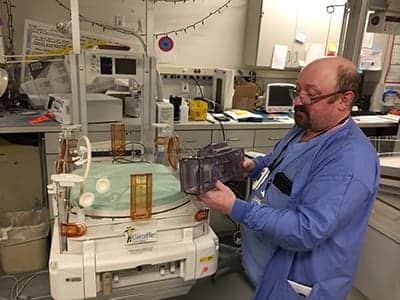
Technician Warner Doctor inspects equipment for one of Cleveland Clinic’s level 3 neonatal intensive care units.
I’ve known many of our employees for 20-plus years and have found that some employees enjoy a gentle transition into retirement. Working part-time for the department can be a great fit. This option has allowed us to take the challenge of workforce retirement and turn it into an opportunity to create a new, flexible, yet experienced, workforce who can support us when our workload is heavy. It’s a win-win—and with no training, we can leverage the part-time caregivers’ skills and local knowledge.
24×7: In your expert opinion, what are the biggest issues currently affecting the HTM field?
Petre: Adopting a mindset and the processes that support cybersecurity will be critical because it requires a new set of tasks and demands a new skillset. We focus first and foremost on safety, and we’re also mindful of compliance and cost-effectiveness. Another challenge is increased regulatory scrutiny while we’re simultaneously trying to drive down support service costs. I believe the solution is to collaborate with manufacturers and regulators to ensure that our work is always adding value for the safety of patients and caregivers—not just checking boxes on a form.
24×7: You mentioned cybersecurity. Can you please discuss the steps Cleveland Clinic’s clinical engineering department is taking to thwart cyberattacks?
Petre: We take the threat of cyberattacks seriously to ensure our patients are kept safe and clinical care isn’t disrupted. The risk of a cyberattack and the tools used to detect, defend, and recover from one are critically important to a health system. [At Cleveland Clinic], our approach is structured around a predict > prevent > detect > respond framework.
24×7: Given the increased connectivity of medical devices, how does your team work with the IT department?
Petre: Medical devices are becoming more connected and, simultaneously, network technology, monitoring, and security is becoming more complicated. There is always a question of whether to build full IT capability into clinical engineering or partner within our organization with IT professionals. I am firmly of the belief that we need to partner because we cannot afford to duplicate those resources (skillsets/caregivers, infrastructure, tools, etc.).
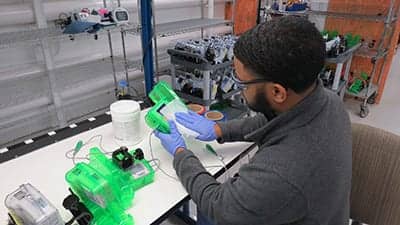
Equipment logistics technician Quan Hearn cleans and performs a functional check on a PCA pump to prepare it for patient use.
We learn a lot from our IT colleagues, and vice versa. We are helping them understand the urgency around medical device issues, and they keep us up to date on the latest technology and processes. I find that it is extremely helpful to work side by side with open lines of communication and build relationships before problems occur. Our best interactions are on a first-name basis; our worst interactions are over email and help-desk tickets.
24×7: What else do you want 24×7 Magazine readers to know about Cleveland Clinic’s clinical engineering department?
Petre: Cleveland Clinic is home to the highest average patient acuity in the United States, which allows us to be part of high-quality care delivery, see specialty equipment in mass—for example, we have more than 40 balloon pumps—and be on the cutting edge of new equipment developments, such as surgical robotics and MRI-guided high-frequency ultrasound ablation.
Our staff frequently collaborates with physicians and nurses on research and development projects. Seeing the impact of our work on patients and building first-name-basis relationships with our clinical partners enhances our work in preventative maintenance completion.


